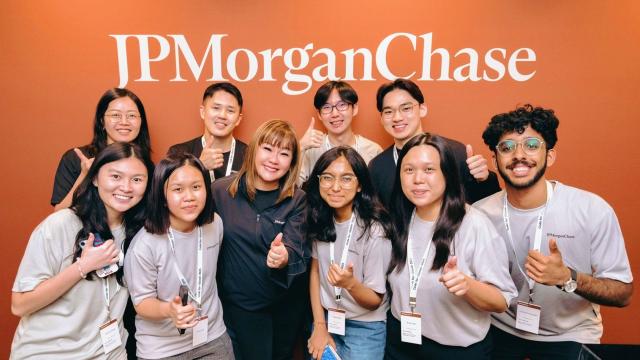Seizing opportunities in the midst of a crisis, SIAEC capitalised on the reduction in workload to accelerate the upskilling and reskilling of its workforce, building capabilities to emerge stronger post-pandemic.

Graduates from SIT’s Bachelor of Engineering in Aircraft Systems Engineering (ASE) who have joined SIAEC as Trainee Aircraft Engineers, undergoing B787 type course training.
While ‘lean’ may not be a new business phenomenon, it was refreshing to learn how the methodology, which originated from the manufacturing & production context in the automobile industry, stood strong as the modus operandi for SIA Engineering Company (SIAEC) in upskilling & reskilling its workforce geared for the highly-niched maintenance, repair, and overhaul (MRO) sector in the aviation industry.
It was at the Applied Learning Conference 2022, the third instalment since its initiation in 2018, where Human Resources Online had the opportunity to dive deep into the aviation sector’s workforce challenges and the innovative upskilling modules that have helped tide over the toughest of times. The conference is organised by the Singapore Institute of Technology (SIT) and was themed ‘Embracing Change in an Era of Disruption’.
This was, in fact, done through SIAEC’s very own Lean Academy (LA), a lean-driven training ground launched in September 2021 to develop its workforce to cope with the ever-changing landscape. Its (initial) goal is simple: Equip the workforce with the lean concept, and empower employees to take a value-driven approach to improve the way they work today, tomorrow, and in the future.
“Lean methodology utilises various tools to improve and sustain flow, which in turn leads to waste reduction,” Tan Hui Boon, Vice President, Training Academy, SIAEC, explains to HRO.
This, Tan adds, is relevant to be applied to MRO operations where wastes, for instance, in terms of “waiting time in getting spares and tools” and “work duplication”, can impact the duration of aircraft checks, and in turn, the date of aircraft delivery to customers.
She highlights that by utilising the lean methodology, it is possible to "improve staff experience, achieve greater efficiency and productivity, and provide our customers with more cost-effective solutions at faster turnaround times”.
“This positions SIAEC ahead of the competition as we are ready to capitalise on the impending recovery of the MRO sector and the aviation industry,” she continues.
Seven months and counting, Tan shares that the lean journey has been “exciting and rewarding”, and the response from the workforce has been “very positive and encouraging”. With results from ongoing lean projects, SIAEC has seen productivity improvements of “up to 30% in turnaround times for certain aircraft checks, as well as shop, and task outputs”.
The Urgency to Build and Rejuvenate Skills
The impact of the COVID-19 pandemic on the aviation industry was unprecedented. The numbers looked bleak – in 2020, total global passenger traffic dropped by 50%, the number of passengers flown dropped by 2.7bn, resulting in excess of $370bn revenue loss for airlines. No other world event caused as much drop in this sector as COVID-19.
“Overnight, there was a surplus of manpower. However, instead of letting our staff go, we seized the opportunity arising from the reduction in workload to reskill and upskill our staff, in preparation for the impending recovery,” Tan reveals.
SIAEC recognises that its people are its key assets and investing in the development of their workforce has a direct impact on the success of the business. As such, there is a strong value attached to the sector’s workforce. Coupled with how highly-regulated the aviation industry is, SIAEC vouches for the approach to building talent in-house, ensuring its workforce has the right skills to meet evolving business needs.
Tan explains: “We adopt a competency-based approach towards learning & development of the workforce.
“Maintaining strong technical skills and capabilities remains the foundation of our MRO workforce. Knowledge and skills in lean is only one part of our workforce competency framework, as it also includes leadership, business, transformation and innovation, digital and other soft skills necessary for our employees to excel in their roles.”
She adds that at the moment, the company is embarking on “a refresh of the competency profiles” where it is considering “evolving business needs” as well as “the importance of emerging skills in the areas of digital and productivity improvements”.
In tandem, SIAEC has accelerated the up- and re-skilling of its employees, especially since the onset of the pandemic, to strengthen workforce resilience and agility in dealing with adversity. Lean training, for example, enables workers to troubleshoot and solve problems effectively, and encourages them to look at new ways in carrying out their duties with a mindset of continuous improvement. This ensures that workers are well prepared to face future challenges head-on, coming out stronger post-pandemic.
That, however, settles the internal piece of the ‘build’ puzzle. As for the external piece, SIAEC has support in the form of an institute of higher learning (IHL).
A Valuable Partnership
SIAEC aims to ensure a steady pipeline of skilled talents, who can benefit not just for the organisation, but for the aerospace industry in many years to come.
This is why SIAEC partnered with SIT. Together, both organisations analysed the needs of the aerospace industry to develop the Bachelor of Engineering with Honours in Aircraft Systems Engineering (ASE), the first degree of its kind by an autonomous university in Singapore. A key feature of the curriculum is an Integrated Work Study Programme (IWSP) at SIAEC over eight months, where students gain first-hand industry experience in aircraft maintenance.
Through this partnership, more talents will be able to enter the aviation sector in roles such as licensed aircraft engineer, process, quality & product engineer, maintenance planner, fleet manager, and technical service & repair development engineer.
The Flight Towards The Future
With the metaverse taking shape, VR/AR, holographs and 3D printing technologies are set to revolutionise the world of business and travel. Though no one can predict how the revolution will be, SIAEC is prepared for it.
The organisation has not only “embraced new technologies, and innovation” but also “embarked on several projects” such as 3D printing of cabin parts, an engine lifter for wide-body aircraft engine change; digital platforms for customers and staff to access information and to facilitate collaboration, as well as digital products with data analytics to improve aircraft reliability.
With regard to upskilling and reskilling, learning & development, and training, SIAEC continues to utilise technology to enhance the learning experience and outcomes.
Tan explains: “[SIAEC] is one of the pioneers in utilising maintenance training simulators from the aircraft manufacturers to improve knowledge transfer, as the simulators allow engineers to reinforce their understanding of the aircraft systems within a controlled environment.
“To enable more exposure to realistic aircraft maintenance environments in a safe and controlled manner, we co-developed VR maintenance training modules to model and simulate maintenance tasks under various scenarios. These scenarios, based on key critical tasks and processes, enhance the training experience and reinforce high safety and quality standards.”
She adds: “Advancements in digital and technology capabilities in operations and business processes that improve efficiency and bring value to customers are key thrusts in strengthening SIAEC’s competitive edge.”
Key Takeaways from the SIAEC Case Study
- Faced with surplus manpower amid an industry ravaged by the pandemic, SIAEC launched the Lean Academy to accelerate enterprise-wide adoption of Lean practices and methodologies.
- Lean training has not only enabled SIAEC’s workforce to troubleshoot and solve problems effectively, but also encouraged them to look at new ways in carrying out their duties with a focus on continuous improvement.
- Lean has also contributed to the development of potential leaders, where championing change and implementation of changes in their work areas have provided opportunities for some employees to hone their leadership skills, contributing to their career development and progression.
- Continual training, especially since the onset of the pandemic, has strengthened workforce resilience and agility in dealing with adversity, ensuring workers are well prepared to face future challenges head-on and emerge stronger post-pandemic.
- Post pandemic, SIAEC is poised to emerge stronger than ever before with a purpose-led workforce. As Tan says, “Our people are our key asset and we believe that investing in the development of our workforce directly contributes to the success of the business.”
– – –
This article first appeared in Human Resources Online.















![[FA] SIT One SITizen Alumni Initiative_Web banner_1244px x 688px.jpg](/sites/default/files/2024-12/%5BFA%5D%20%20SIT%20One%20SITizen%20Alumni%20Initiative_Web%20banner_1244px%20x%20688px.jpg)


